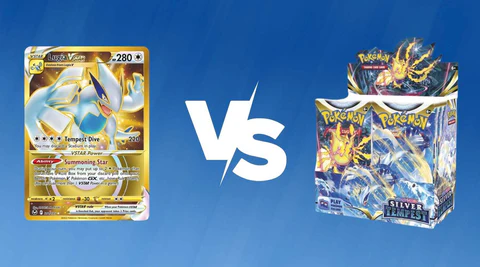Collectors and investors face a classic dilemma: Should you invest in sealed booster boxes or chase valuable single cards? In 2025, both options offer strong ROI. Let’s break down their strengths, risks, and strategies—with comparisons, data, and real-world examples.
📈 Understanding the Market Trends
A mid‑year analysis comparing sealed booster boxes and total card value shows that sealed boxes have consistently outperformed singles across post-Sun & Moon sets. The Reddit community summarizes it well:
“Sealed booster boxes vs singles for every main Pokémon set … sealed for investing, singles for collecting”
“I follow the motto: Singles for collecting and sealed for investing.”
This sets the stage: sealed boxes provide appreciation stability, while singles offer higher margin flips—each with its own advantages.
📊 Investment Comparison Table
| Metric | Sealed Booster Boxes | Chase Single Cards |
|---|---|---|
| Average ROI | Consistent double-digit growth | Highly variable: from –10% to +500% |
| Initial Cost | High (e.g., $150–$300 per box) | Variable ($5–$1,000+ per card) |
| Storage Requirements | Bulky / climate-sensitive | Compact (sleeves or slabs) |
| Liquidity | Slower to sell; fewer buyers | Easier fast sales; large audience |
| Risk Factors | Lower downside unless reprints | Card-specific; popularity shifts |
| Time & Effort | Minimal maintenance | Requires tracking singles and trends |
Sealed Booster Boxes: The Safer Bet
Pros:
- Predictable appreciation. Boxes rarely lose value unless reprints hit; they act like ETFs for Pokémon Elite FourumMedium.
- Broad spread exposure. You bet on the entire set, not one card.
- Rarity by default. Sealed boxes are limited over time.
Cons:
- Requires physical storage space.
- Higher upfront cost and potential shipping or tariff fees.
Sample Return On Investments [ROI]
For example, the VSTAR Universe Japanese box might cost $150 today and land near $300–$350 in 18–24 months—yielding ~100% ROI. Tables from Reddit confirm most booster boxes since Sun & Moon show double-digit gains Elite Fourum.
Chase Single Cards: High-Risk, High-Reward
Pros:
- Potential for exponential gains—some chase cards yield +200–500% on hype.
- Low barrier to entry: you can start with $20–$30 cards.
- Easy to store and highly liquid—sell anytime.
Cons:
- Picking winners demands effort, research, and luck.
- Cards can fall out of favor fast.
- Grading and authenticity issues may arise.
Example Scenario
Buying a $300 Umbreon ex SIR today could fetch $800+ at peak hype—more than doubling, but only if timed well. Mistimed plays can result in large losses.
🧠 Expert Insights
An online poll from EliteFourum shows sealed boxes are considered safer:
“Sealed product has increased in value consistently. Boxes bought at release and held… are one of the least risky purchases.” YouTube+11Elite Fourum+11Elite Fourum+11MediumReddit
Another user adds:
“Once a box reaches a certain price‑point, you know it is going to maintain that, whatever the market does.” Elite Fourum
📌 Side-by-Side ROI Example
Let’s compare a sealed Prismatic Evolutions box vs a chase Charizard ex card:
- Prismatic Evolutions Box
- Buy price: $200
- Expected sell price in 2 years: $400–$500
- ROI: +100% to +150%
- Charizard ex SIR (from the same set)
- Buy price: $40
- Peak sell price: $120–$150
- ROI: +200% to +275%, but only if timed correctly
Takeaway: Singles offer higher upside but come with market timing risk. Boxes offer slower, steadier returns.
🧾 Strategy for Each Type
Sealed Booster Box Strategy:
- Buy at or near MSRP upon release.
- Hold sealed for 12–24 months—during which value tends to rise.
- Store properly (cool, dry, intact seals).
- Track market records to identify sale peaks.
Chase Single Cards Strategy:
- Identify high-demand cards (e.g., alternate art, secret rares).
- Buy graded examples when supply dips.
- Stay updated on meta and collecting trends.
- Time your sale when hype peaks—eBay, TCGPlayer, or auctions.
📦 Combination Approach: The Best of Both Worlds
Many seasoned investors follow a hybrid strategy:
- Buy 2–3 booster boxes per set for long-term hold.
- Split some funds into singles of promising cards.
This protects against volatility while maintaining upside potential.
Tactical Example
Set: VSTAR Universe Japanese box
- Cost per box: $150
- Estimated multiset ROI: +100% in 18 months
Chase Cards within:
- Charizard ex (alt-art): $40 → $120
- Rare Trainer Full Art: $10 → $30
Outcome:
- Box: +$150 profit
- Cards: +$200 profit (combined)
Total profit: ~$350 per box
⚠️ Risks to Consider
- Market saturation may slow returns on some modern sets
- Long-term holding requires space and possible insurance.
- Singles need precise timing and authentication.
🧭 Final Comparison
| Feature | Sealed Boxes | Chase Singles |
|---|---|---|
| ROI Potential | Moderate and steady | High, but volatile |
| Skill Required | Low | High (market tracking, grading) |
| Space Needs | Bulky, needs safe storage | Minimal; easy to store and ship |
| Timing Risk | Lower | High; must sell at peak value |
| Time Investment | Low (buy and hold) | High (research & sales) |
| Diversification | Built-in set exposure | Must diversify across multiple cards |
👑 Conclusion: Which is Better?
It depends on your goals:
- For low-risk, long-term gains, sealed booster boxes are the preferred path.
- For higher potential returns and flexibility, chase single cards can pay off—but require expertise.
- Many investors combine both strategies to balance stability and profit.
🔗 Looking To Buy Sealed Booster Boxes?
If you’re interested in sealed S & V booster boxes, consider JapaneseTCGBoosterBox.com. They offer authentic, factory-sealed Japanese boxes—perfect for long-term investment.

